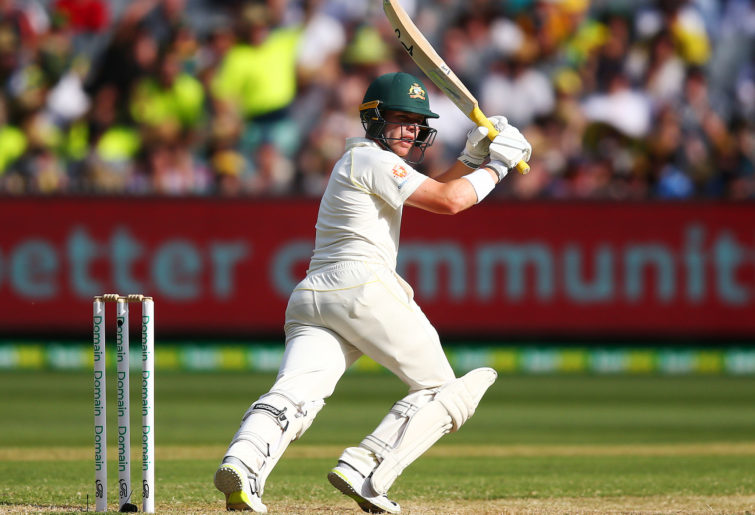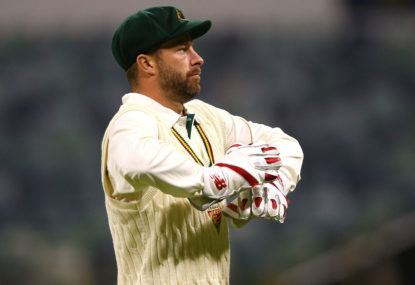Matthew Wade has been nominated as a solution to Australia’s Test batting woes by legends Ricky Ponting and Shane Warne after the home side’s top six floundered in the Boxing Day Test.
Australia look likely to make at least one, if not more changes to their batting lineup for the deciding Test in Sydney after being bowled out for 151 in the first innings at Melbourne and falling to 6-157 in the second dig.
Using a specialist batsman spot on Wade, who averaged 20 over 10 Tests during his last stint in the Aussie side, would disrespect the likes of Glenn Maxwell, Joe Burns and Kurtis Patterson – three players far better suited to such a role.
While commentating for Fox Sports yesterday, Warne suggested Wade was the only batsman outside of the Test team who had been in good enough first-class form to warrant coming into the team. Ponting, meanwhile, said Wade should be next in line for a batting spot.
Wade is certainly in fine form. He is the leading runscorer in the Sheffield Shield this season, with 571 runs at 63, after making 654 runs at 43 in the last Shield season.
He’s also a 31-year-old wicketkeeper who was tried and failed across 22 Tests. Wade has had more and better opportunities at Test level than either of Maxwell or Burns, while Patterson has never even been given a crack.
When David Warner and Steve Smith were banned, I argued the silver living of their absence was that Australia could get lots of game time into less experienced batsmen to try to build depth. That opportunity largely has been wasted. The selectors have made a litany of mistakes. First and foremost they have erred by sticking with the Marsh brothers in the desperate hope they would finally come good.
They’ve also cruelled Aaron Finch’s chance of building a Test career by batting him completely out of position as an opener. Meanwhile, the recall of Peter Handscomb was a glaring error. Handscomb was dropped because of the way his curious technique was exposed by England. Then he went away, refused to change his approach and averaged just 34 in first-class cricket in between being axed in the Ashes and returning this summer.
How could this sequence of events possibly justify Handscomb being reinstated to the Test team?

(Photo by Ryan Pierse/Getty Images)
Australia seem intent on returning to the same flawed batsmen again and again. Instead of learning something about their batting stocks while Smith and Warner were gone, they have largely just confirmed what was already obvious.
With just three Tests left before the Ashes next year, Australia have limited time to try to bed down their batting lineup for that massive series. Smith and Warner are locks to return for the Ashes as I see it. Other than that star pair, only first drop Usman Khawaja appears a certainty. The Marsh brothers surely cannot survive that long, Handscomb should not be recalled any time soon and Finch has looked out of his depth as an opener in this series, averaging 16 from six innings against India.
Greater patience should be shown with newcomers Travis Head and Marcus Harris. Head might only be averaging 34 with the bat after five Tests but he hasn’t looked out of his league at Test level. Among his ten Test innings, he has played three which were of enormous value in difficult circumstances.
First, he made a grinding 72 on debut in Dubai to help Australia to a rousing draw. Then he top-scored for Australia with 72 in the first innings of a low-scoring Test against India in Adelaide. Most recently he made 58 on a tricky pitch at Perth after coming in with Australia in trouble at 4-148.
Since that knock Head has wasted three starts, making 19, 20 and then 34 yesterday. His major shortcoming is the way he gets goaded into slashing at wide deliveries. Head deserves time to see if he can resolve this issue.
Harris, meanwhile, has looked very good at times in this series but, like Head, is not exploiting his starts. His 70 in the first innings at Perth set up a victory for Australia, but otherwise he has made four scores in the 20s. During his period mentoring Harris at WA, now Australian coach Justin Langer became frustrated by the manner in which Harris would move smoothly to 20 or 30 and then give it away.
A similar pattern has emerged in his brief Test career. But Harris has shown enough to warrant playing the next three Tests to round off the summer.

(Photo by Michael Dodge/Getty Images)
Finch, I sense, will get the final Test against India to try to save his spot. If he fails again at Sydney he should be replaced by Burns for the two-Test series against Sri Lanka. And if the Marsh brothers are dropped in the short term then it should not be Wade who comes into the team but instead Maxwell and Patterson.
Maxwell averages 41 in first-class cricket, has made 833 runs at 49 across the past two Shield seasons, made a Test ton in India last year, and averaged 37 across four Tests in Asia during his last stint in the side. The all-rounder has been messed around to a ridiculous extent by the selectors.
His seven Tests have come across three separate stints in the Australian team. What’s unfathomable is that, in just 14 Test innings, Maxwell has been asked to bat in seven different positions – opener, 3, 4, 5, 6, 7 and 8.
Maxwell should come into the side for the final Test at the expense of Mitch Marsh, who failed as an apparent horses-for-courses selection at the MCG. Once the elder Marsh is axed, his spot should be taken by Patterson.
The knock on Patterson has been his inability to converts fifties into hundreds. It is a justified criticism considering he has made just six tons from 58 first-class matches. The flipside is that Patterson has managed to average 41 at the first-class level without inflating that average via big tons.
He is an ultra-consistent contributor for NSW. Over the past four Shield seasons, he has averaged 53, 45, 37 and 48. Underlining his consistency is the fact that, across 61 innings in that period, he has 21 scores of 50-plus.
Patterson has also impressed in that time for Australia A, making 343 runs at 43 across five first-class matches. The tall left-hander has a capacity for making tough runs, as he underlined with his Man of the Match performance in the Shield against WA a month ago. In a very low-scoring match on a lightning Perth Stadium pitch against a strong WA attack, Patterson made 107 and 43 batting at first drop. At 25 years of age, with almost 4,000 first-class runs to his name, he has an appealing mix of youth and experience.
It would make so much more sense to offer an opportunity to Patterson than to try to turn 31-year-old wicketkeeper Wade into a Test batsman.































































































